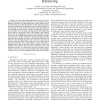Free Online Productivity Tools
i2Speak
i2Symbol
i2OCR
iTex2Img
iWeb2Print
iWeb2Shot
i2Type
iPdf2Split
iPdf2Merge
i2Bopomofo
i2Arabic
i2Style
i2Image
i2PDF
iLatex2Rtf
Sci2ools
INFOCOM
2007
IEEE
2007
IEEE
Multiple-Choice Random Network for Server Load Balancing
Abstract—In many networking applications such as file sharing, structured peer-to-peer networks are increasingly used in dynamic situations with fluctuating load, which require proper load balancing. The relationship between the network structure and its load-balancing properties has not been fully understood. In this paper, we focus on the Plaxton-type networks, which are broad enough to include Pastry, Tapestry, and hypercube. We first use hypercube as an example and demonstrate that replicating files at nodes in decreasing order of the length of the common prefix with the original server leads to perfectly balanced load, and does so fast and efficiently. Moreover, this replication strategy coincides with a simple on-demand replication/caching strategy based on the observed load. One of our main contributions is to show that such desirable properties also exist for a large class of random networks, which are less restrictive and more practical than the hypercube. More importa...
Related Content
| Added | 03 Jun 2010 |
| Updated | 03 Jun 2010 |
| Type | Conference |
| Year | 2007 |
| Where | INFOCOM |
| Authors | Ye Xia, Alin Dobra, Seung Chul Han |
Comments (0)

